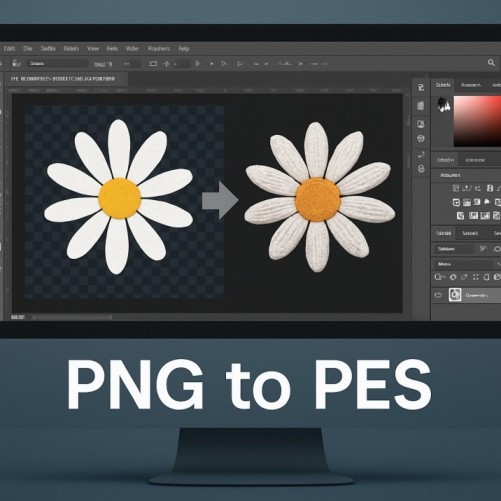Embroidery merges technology and creativity, captivating thestarbiznews.com’s entrepreneurial readers. Converting PNG to PES transforms digital images into machine-readable embroidery files, ideal for branding apparel, crafting gifts, or enhancing decor. This guide explores the PNG to PES conversion process, its business applications, and practical tips, tailored for thestarbiznews.com’s innovative readers. With over a decade of expertise, True Digitizing simplifies this for hobbyists and businesses. Let’s unlock embroidery’s potential!
What Are PNG and PES Files?
PNG: The Digital Foundation
A PNG (Portable Network Graphics) is a raster image format prized for its high quality and transparent backgrounds. Used for logos or digital art, PNGs rely on pixels, requiring conversion for embroidery machines.
PES: The Embroidery Guide
A PES (Brother Embroidery Format) is a vector-based file for machines like Brother, Babylock, or Bernina. It stores stitch instructions—thread colors, stitch types (e.g., satin, fill), and paths—for precise embroidery. Converting PNG to PES makes designs machine-ready.
Why Convert PNG to PES?
The PNG to PES conversion process offers compelling benefits:
- Precision: PES files ensure accurate stitching for complex designs.
- Scalability: Resize designs without quality loss, unlike pixel-based PNGs.
- Customization: Craft branded logos, monograms, or decor for business or personal use. This aligns with thestarbiznews.com’s focus on tech-driven entrepreneurship, enabling innovative product creation.
Step-by-Step Conversion Guide
Step 1: Prepare Your PNG
Start with a high-resolution PNG (300 DPI or higher):
- Simplify using tools like GIMP or Adobe Photoshop, removing gradients or fine details.
- Use bold shapes and 3–5 colors for embroidery-friendly designs.
- Save with a transparent background to isolate the design.
Step 2: Select Software
Choose software suited to your needs:
- SewArt: Affordable and user-friendly (free trial at sewartembroidery.com).
- Ink/Stitch: A free Inkscape extension for basic conversions.
- Wilcom Hatch: Professional-grade for intricate designs. Ensure the software exports PES files compatible with your machine.
Step 3: Digitize the Design
Import the PNG into your software:
- Trace to create stitch paths, using auto-digitizing for simple designs or manual tracing for detailed ones.
- Assign thread colors, referencing charts like Isacord or Madeira.
- Set stitch types (e.g., satin for outlines, fill for solid areas) for texture.
Step 4: Test and Save
Export as a PES file and test on scrap fabric to verify:
- Stitch alignment to avoid gaps or overlaps.
- Color accuracy to match the PNG.
- Durability for washing or wear. Adjust settings, then transfer the PES file to your machine via USB or wireless.
Benefits for Crafters and Businesses
PNG-to-PES conversion empowers thestarbiznews.com readers:
- Crafters: Create personalized gifts (e.g., embroidered bags, blankets) or home decor (e.g., stitched pillows, wall art).
- Businesses: Produce branded apparel, uniforms, or promotional items for online sales, enhancing brand visibility.
- Efficiency: Reusable PES files streamline production, cutting costs for small businesses. This process supports entrepreneurial innovation, a core focus of thestarbiznews.com.
Expert Tips for Success
The PNG to PES process excels with these tips:
- Use High-Quality PNGs: Low-resolution images yield fuzzy stitches. Start with sharp files.
- Simplify Designs: Complex PNGs with many colors can clog stitches. Streamline in tools like Inkscape.
- Match Fabrics: Test PES files on project-specific materials (e.g., cotton for apparel) to avoid puckering.
- Test Stitches: Run a sample stitch to catch errors early.
- Consider Pros: Professional services offer fast turnarounds (2–12 hours) with free previews for complex designs.
Common Mistakes to Avoid
- Low-Quality PNGs: Pixelated images reduce stitch clarity. Use high-resolution files.
- Overcomplicating Designs: Too many details lower quality. Stick to simple shapes.
- Ignoring Fabric Needs: Stitch settings vary by material. Test on target fabrics.
- Skipping Tests: Testing PES files prevents costly errors. Always test first.
Tools for Conversion
- Free Options: Ink/Stitch (Inkscape extension) or OnlineConvertFree for budget crafters.
- Paid Software: SewArt (affordable) or Wilcom Hatch (professional-grade) for advanced control.
- Professional Services: Experts ensure machine-ready files for complex or urgent projects.
Ideas for Thestarbiznews.com Readers
- Gift Crafting: Embroider coasters or bookmarks for unique business gifts.
- Business Branding: Create stitched logos on apparel or bags for e-commerce ventures.
- Event Swag: Produce custom t-shirts or patches for community or corporate events.
Conclusion
Converting PNG to PES unlocks embroidery opportunities for thestarbiznews.com’s tech-savvy entrepreneurs. With tools like SewArt or professional services, anyone can transform digital designs into vibrant stitched products. Follow these steps, avoid common pitfalls, and start crafting branded or personalized creations today. Thestarbiznews.com readers, grab a PNG and stitch your business vision into reality!







